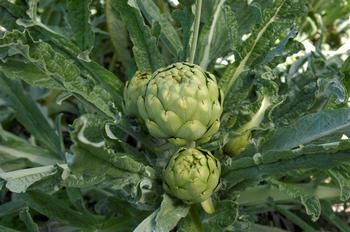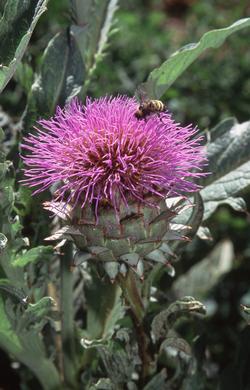Gorgeous artichokes are easy to grow for food or flowers
-
Julie McMillan
-
Artichokes are stunning with silvery, spikey foliage and thrive in Marin’s Mediterranean climate. They are easy to grow and delicious to eat, or you can let them flower for brilliant purple blossoms.
The Spanish brought artichokes to California, and since the 1920s Monterey County has produced almost the entire US crop. In 1947, Castroville, the “artichoke capital of the world,” crowned its first Artichoke Queen, Norma Jean (a/k/a Marilyn Monroe). In 2013, artichokes were named our state vegetable. Artichokes are about ready for harvest. Photo credit: istock
Artichokes are about ready for harvest. Photo credit: istockArtichokes are a perennial, lasting more than one year, in the thistle tribe of the sunflower (Compositae) family. They are extremely hearty; for example, 40 years after operations had ceased, artichokes were rediscovered on Alcatraz in 2003.
California grows two types of artichokes. ‘Green Globe’ accounts for nearly 90% and thrives in northern California. You can buy ‘Green Globe ‘as a rootstock in potted nursery plants or seed. The other type, ‘Imperial Star’, is a low chill variety, ideal for warmer places like southern California.
The best time to plant artichokes is in the spring. Our mild Marin winters provide just enough chill to stimulate ‘Green Globe’ bud formation, but rarely enough to cause damage; cool springs and summers produce large, tender buds. Artichokes need a lot of space: 3-4’ wide, and 3’ to as high as 6’. They need at least 4-6 hours of sun per day. Artichokes prefer deep, fertile, and well-drained soil; raised beds work well. To prepare the soil, add plenty of compost. Artichokes need consistent watering, especially during dry spells in spring or fall. Drip irrigation works better than sprinklers. When actively growing, artichokes like a monthly boost of high nitrogen liquid fertilizer. If correctly cared for, production can be maintained in a plant for 5 years or more.
There are usually three artichokes to a stem, but sometimes as many as ten. We eat the part of the artichoke called bracts, the leaves that surround many immature flower buds, along with the heart, the fleshy base that supports the flowers. Harvest your artichokes when the buds have grown to maximum size, but before the bracts begin to open. Buds left on the plant past their prime become woody and bitter, and then will start to flower. Artichoke flowers are magnets for bees. Photo credit: Jack Kelly Clark, UCSF IPM program
Artichoke flowers are magnets for bees. Photo credit: Jack Kelly Clark, UCSF IPM programExpect two crops of artichokes per year – one in the spring and another in the fall. After your spring harvest, cut off the old stalks just below the ground and cover with organic mulch. Then reduce or withhold water for several weeks to allow for a summer dormancy. Once you resume irrigation, new shoots will develop to produce a fall crop. Repeat this process after your fall harvest. Several times a year prune the plant back to stimulate new shoots.
If you allow your artichokes to flower, you will enjoy dazzling purple flowers that attract many bees. They also make magnificent cut flowers. A word of caution: An open flowering bud will inhibit the rest of the plant from making more buds. So if you want flowers, leave one plant unharvested, or let some of the side buds bloom at the end of the season.
Artichokes are generally pest and disease free, but may attract aphids. A minor infestation does little damage, but a heavy outbreak can attract ants to feed on the honeydew. This summer we had aphids that attracted hundreds of ladybugs, quickly eliminating the outbreak.
A 12-ounce artichoke has about 25 calories, no fat, vitamin C, folic acid and magnesium. Some people like to dip their artichokes in butter or mayonnaise. Try pairing yours with my favorites, mayonnaise, lemon and pepper!


